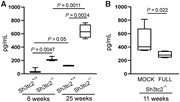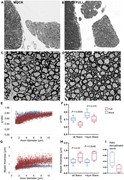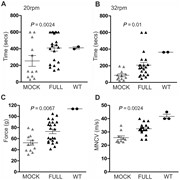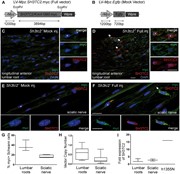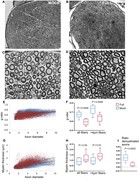Skip to results
Search Results for
gene replacement therapy in a model of Charcot-Marie-Tooth 4C neuropathy
Modify your search
NARROW
1-14 of 14 results for
gene replacement therapy in a model of Charcot-Marie-Tooth 4C neuropathy
Sort by
Journal Article
Gene replacement therapy in a model of Charcot-Marie-Tooth 4C neuropathy
Natasa Schiza and others
Brain, Volume 142, Issue 5, May 2019, Pages 1227–1241, https://doi.org/10.1093/brain/awz064
Published: 25 March 2019
... onset progressive peripheral neuropathy with hypo- and demyelination, slowing of nerve conduction velocities and disturbed nodal architecture. The aim of this project was to develop a gene replacement therapy for treating Charcot-Marie-Tooth disease type 4C to rescue the phenotype...
Journal Article
NCAM1 and GDF15 are biomarkers of Charcot-Marie-Tooth disease in patients and mice
Matthew J Jennings and others
Brain, Volume 145, Issue 11, November 2022, Pages 3999–4015, https://doi.org/10.1093/brain/awac055
Published: 11 February 2022
... identify proteins in sera of patients and mouse models with Charcot-Marie-Tooth disease (CMT) with characteristics that make them suitable as biomarkers in clinical practice and therapeutic trials. We collected serum from mouse models of CMT1A (C61 het), CMT2D (GarsC201R...
Journal Article
Neuropathy due to bi-allelic SH3TC2 variants: genotype-phenotype correlation and natural history
Get access

Tyler Rehbein and others
Brain, Volume 146, Issue 9, September 2023, Pages 3826–3835, https://doi.org/10.1093/brain/awad095
Published: 22 March 2023
... . 17 Schiza N , Georgiou E , Kagiava A , et al Gene replacement therapy in a model of charcot-marie-tooth 4C neuropathy . Brain . 2019 ; 142 : 1227 – 1241 . 18 Colomer J , Gooding R , Angelicheva D , et al Clinical spectrum of CMT4C disease in patients...
Journal Article
Novel gene–intergenic fusion involving ubiquitin E3 ligase UBE3C causes distal hereditary motor neuropathy
Anthony N Cutrupi and others
Brain, Volume 146, Issue 3, March 2023, Pages 880–897, https://doi.org/10.1093/brain/awac424
Published: 16 November 2022
... CA , Kuwano A , et al Gene dosage is a mechanism for Charcot–Marie–Tooth disease type 1A . Nat Genet. 1992 ; 1 : 29 – 33 . 37 Patel PI , Roa BB , Welcher AA , et al The gene for the peripheral myelin protein PMP–22 is a candidate for Charcot–Marie–Tooth disease...
Journal Article
Induced pluripotent stem cell-derived motor neurons of CMT type 2 patients reveal progressive mitochondrial dysfunction
Jonas Van Lent and others
Brain, Volume 144, Issue 8, August 2021, Pages 2471–2485, https://doi.org/10.1093/brain/awab226
Published: 15 June 2021
... approved by the Committee for Medical Ethics, University of Antwerp. Abstract Axonal Charcot-Marie-Tooth neuropathies (CMT type 2) are caused by inherited mutations in various genes functioning in different pathways. The types of genes and multiplicity of mutations reflect the clinical and genetic...
Journal Article
Homozygous COQ7 mutation: a new cause of potentially treatable distal hereditary motor neuropathy
Arnaud Jacquier and others
Brain, Volume 146, Issue 8, August 2023, Pages 3470–3483, https://doi.org/10.1093/brain/awac453
Published: 01 December 2022
... the first familial cases of patients affected by COQ7 mutation and presenting with a pure distal motor neuropathy. We show that the c.3G>T (p.1Met?) mutation in the COQ7 gene causes a decrease in COQ7 protein levels, leading to an accumulation of 6-DMQ, a decrease in CoQ10 levels...
Journal Article
Downregulation of PMP22 ameliorates myelin defects in iPSC-derived human organoid cultures of CMT1A
Jonas Van Lent and others
Brain, Volume 146, Issue 7, July 2023, Pages 2885–2896, https://doi.org/10.1093/brain/awac475
Published: 13 December 2022
... containing medium was removed 48 h after transduction and replaced by D9 differentiation medium. Abstract Charcot–Marie–Tooth disease is the most common inherited disorder of the PNS. CMT1A accounts for 40–50% of all cases and is caused by a duplication of the PMP22 gene on chromosome 17, leading...
Image
Assessment of serum NfL levels in Sh3tc2−/− mice at bas...
Published: 25 March 2019
Figure 6
), as well as at 25 weeks of age ( P = 0.0024; n = 4 Sh3tc2 −/− and n = 2 Sh3tc2 +/+ mice). The elevation of NfL concentration in Sh3tc2 −/− mice increased significantly from 6 to 25 weeks of age ( P = 0.0011), indicating progressive axonal dysfunction in this model of demyelinating neuropathy
Journal Article
Studying human nociceptors: from fundamentals to clinic
Steven J Middleton and others
Brain, Volume 144, Issue 5, May 2021, Pages 1312–1335, https://doi.org/10.1093/brain/awab048
Published: 21 June 2021
... repair. Cellular models of human nociceptors have enabled the screening of small molecule and gene therapy approaches on nociceptor function, and in some cases have enabled correlation with clinical outcomes. Undoubtedly, challenges remain. Many of these techniques are difficult to implement at scale...
Image
Morphometric analysis of anterior lumbar roots. Representative low ( A an...
Published: 25 March 2019
Figure 3
Morphometric analysis of anterior lumbar roots. Representative low ( A and B ) and higher magnification ( C and D ) images of toluidine blue-stained semithin sections from anterior lumbar spinal roots of 11-week-old mock- ( A and C ) and full vector- ( B and D ) treated Sh3tc2 −/− mice.
Image
Behavioural and electrophysiological analysis of treated Sh3tc2−/−...
Published: 25 March 2019
Figure 2
Behavioural and electrophysiological analysis of treated Sh3tc2 −/− mice. Improved rotarod motor performance was observed at two different speeds tested, 20 rpm ( A ) and 32 rpm ( B ), in full vector-injected Sh3tc2 −/− mice ( n = 21) compared to mock vector-treated mice ( n = 12), as well
Image
Improvement of nodal phenotype in treated Sh3tc2−/− mic...
Published: 25 March 2019
Figure 5
Improvement of nodal phenotype in treated Sh3tc2 −/− mice. Immunostaining of sciatic nerve teased fibres from mock ( A ) or full vector ( B ) treated Sh3tc2 −/− mice shows expression of myc-tagged SH3TC2 (green) only in treated fibres (open arrowheads in B ) around the Schwann cell nucleus (
Image
Expression analysis of LV-Mpz.SH3TC2.myc vector. Map of the LV-...
Published: 25 March 2019
Figure 1
Expression analysis of LV- Mpz.SH3TC2.myc vector. Map of the LV- Mpz.SH3TC2.myc ( A ) and LV- Mpz.Egfp ( B ) transfer plasmids used for the full and mock lentiviral vector production, respectively. Longitudinal sections of lumbar roots ( C and D ) and sciatic nerves ( E and F ) from Sh3tc2
Image
Morphometric analysis of mid-sciatic nerves. Representative low ( A and ...
Published: 25 March 2019
Figure 4
Morphometric analysis of mid-sciatic nerves. Representative low ( A and B ) and higher magnification ( C and D ) semithin sections from mid-sciatic nerves of 11-week-old mock- ( A and C ) and full vector- ( B and D ) treated Sh3tc2 −/− mice. Mock-injected mice show thin myelin sheaths in
Advertisement
Advertisement


